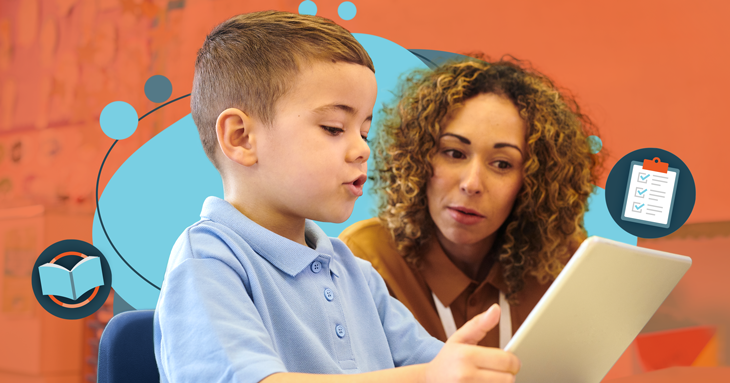
4 Ways Reading Assessments Make You a Better Teacher
Reading assessment informs instruction and is an essential part of any literacy curriculum (Afflerbach, 2017). Students enter our classrooms with different backgrounds and a wide range of literacy skills. To effectively meet the needs of our diverse learners, we need to provide targeted, differentiated instruction based on instructional needs.
Identifying instructional needs involves knowing each student’s ability to decode new words, along with their level of fluency and reading comprehension. Comprehensive literacy assessments are typically done at the beginning, middle, and end of the year. In between, regular progress monitoring helps teachers understand what’s resonating and where students might need extra support.
With regular assessment, you will have data at your fingertips to help you target your instruction. Below we will discuss 4 important ways reading assessments can inform your teaching. We will then explain how the assessment feature on our Digital Reader can provide information about your students’ skills and help you identify instructional needs and monitor student progress.
What Is a Reading Assessment?
Reading assessments form one part of a comprehensive assessment program. For teachers to get a broad view on student reading progress, they need to understand specific reading skills, along with phonic/word study knowledge and writing aptitude. Within this framework, a reading assessment can help you pinpoint specific reading skills. Some of the skills targeted include:
- letter knowledge
- reading accuracy
- phonemic awareness
- phonics
- comprehension
- vocabulary
- fluency
How Reading Assessments Help You Target Your Teaching
Regular assessment gives you insight into student progress but can also yield data that will make your teaching more efficient and bolster student success. Here are 4 ways you can leverage reading assessment data to improve your teaching.
1: Identify Reading Skills and Group Students According to Instructional Needs
Forming groups is an important aspect of small-group instruction. You can use assessment data to make sure you are setting up your students for success and maximizing learning for each group.
For small-group instruction, it’s important to know the reading level for each of your students. This is particularly important at the beginning of the school year. Some students may have made great progress over the summer, while others may have experienced some summer slide. Knowing this information will make you more effective when it comes to working with your students.
2: Monitor Student Progress
It is important to determine if students are making adequate progress as they learn to read. Progress monitoring can help you know if you need to adjust instruction for your students.
Regularly monitoring student progress is also important to help you keep your groups effective. It’s common to regroup individuals regularly over the course of a school year.
Ongoing assessments can also help you identify if a student is not making progress and needs extra support from a more intensive literacy intervention.
3: Guide Instruction
Assessments can help you adjust group instruction if you find students aren’t grasping a skill or need review. Reading assessments help teachers make informed decisions for individual students.
As you review assessment data, ask yourself the following questions:
- Are students understanding what they are reading?
- Are they gaining new vocabulary and becoming more fluent?
- What kind of words are they struggling to decode?
4: Evaluate the Effectiveness of Instruction
Assessments can provide feedback to you and school administrators about the effectiveness of your literacy curriculum.
Some things to look for when analyzing classroom data include:
- What kind of overall progress is the class making?
- How does their progress compare to other students in the school?
- Is there anything missing from what they are learning?
The Digital Reader Assessment and Data Center
The Digital Reader Assessment and Data Center can provide you with robust assessments and the ability to monitor individual and class progress. There are three kinds of assessments available on the platform:
1. Reading Assessment: This assessment provides you with a quick way to know where to start instruction for each student. Here, you use leveled texts that help you evaluate reading accuracy, fluency, and comprehension. In addition, there are progress monitoring assessments available on select books throughout the Digital Reader library.
2. Word Study Assessment: A word study assessment helps you gain information about student knowledge of letters, sounds, and encoding skills.
3. Writing Assessment: A robust writing assessment provides you with feedback on student writing and next steps for examining writing skills.
Watch the following video to learn more about all of the assessment features on the Digital Reader.
Back to School Assessments with the Digital Reader
Reading assessments are an important tool for teachers. By using reading assessments, teachers can identify students’ reading skills, monitor student progress, guide instruction, and evaluate the effectiveness of instruction. The Digital Reader Assessment and Data Center is a vital resource that can help teachers assess students’ reading skills and track their progress over time.
Try Us Out!
Sign up for a free 2-week trial of the Digital Reader to access our amazing assessment resources! Your trial of this expansive resource will include access to:
- Assessment and Data Center: track student progress, identify instructional reading levels, and differentiate instruction with our easy-to-use assessment tools.
- Guided Reading Assessment Kit: get a reading accuracy rate for each of your students to determine their instructional reading level.
- Two books per reading level: engage readers at every level with two books that have been developed and tested specifically for assessment.
Sign up today, and see how the Digital Reader can enhance your instruction and help students improve their reading skills!

